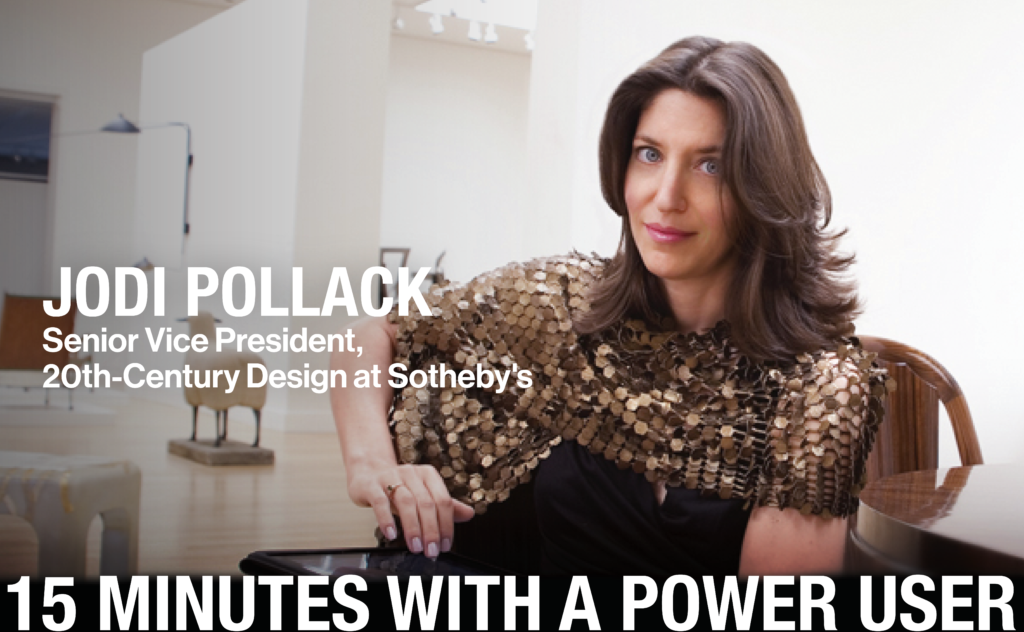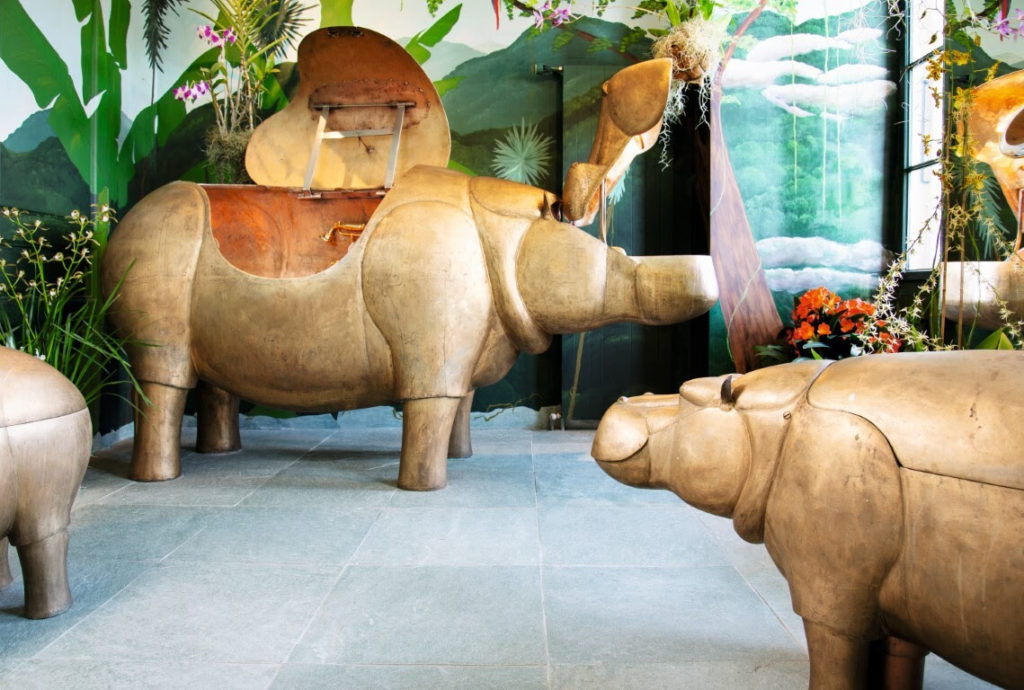Galleries
15 Minutes with a Price Database Power User: Sotheby’s Design Impresario Jodi Pollack
The leader of Sotheby’s 20th-century design department tells us about the latest design trends—and what's undervalued.

The leader of Sotheby’s 20th-century design department tells us about the latest design trends—and what's undervalued.

Artnet Price Database Team

Art-world insiders trust one tool to buy, sell, and research art: the Artnet Price Database. These users cross industries—from auction houses and galleries, to museums and government institutions—and represent the art world’s most important players. We’re taking 15 minutes to chat with some of the Artnet Price Database’s power users to get their take on the current state of the market and how they’re keeping up with the latest trends.
Growing up in Chicago, Sotheby’s Senior VP Jodi Pollack would go for after-school jaunts to design shops with her mother, sparking a lifelong fascination with art and design. Today, you can find her at the helm of Sotheby’s 20th-Century Design department, which, under her leadership, has sold more than $100 million over the past three years in its New York auctions alone.
We sat down with Jodi to talk about the global design market, what designers are hot right now, and most importantly, which collecting category is the most recession-proof.
This year is your 20th anniversary with Sotheby’s. How have you seen the design market change over the past two decades?
The market has changed enormously over this time. I think the biggest transformation has been the shift in collecting ideology, from “connoisseur” collecting concentrated in one particular field, to a more eclectic collecting approach largely driven by decorating. Twenty years ago, many of the top collectors were building comprehensive collections concentrated in one area, such as American Arts & Crafts or French Art Deco, and their interiors reflected this focused commitment. Today, many of our most active buyers have multiple homes around the world, and they are creating incredible environments layered with art, design, and decorative arts from a variety of periods and genres.
What categories within the field of modern and contemporary design are really hot with collectors right now?
The biggest names in recent seasons have been Les Lalanne, Diego and Alberto Giacometti, and Jean Royère. That said, works representing the very best in quality across every market—whether prewar, postwar, or contemporary design—always resonate with advanced collectors.
What categories, periods, or designers within the sector do you see as currently undervalued? Which ones are overvalued?
There are great opportunities in many of the more classic prewar markets today, including American and British Arts & Crafts, Art Nouveau, and French Art Deco. These periods represent extraordinary craftsmanship and quality at very good values today. Some of the postwar markets that have seen accelerated rises, like Lalanne and Giacometti, seem like they are due for a correction, though the strong global demand we continue to see makes this unlikely anytime soon.
Personally, what’s your favorite design period?
I love it all! Today I live with a lot of American, Scandinavian, and Italian postwar design, mixed with contemporary design.

François-Xavier Lalanne’s Famille d’Hippopotames (1992), for sale in Sotheby’s upcoming “Important Design” auction, taking place June 29, 2020.
You’ve been incredibly successful selling Tiffany glass, including the record-setting sale of a window from a church in Erie, Pennsylvania for $2.7 million in 2016—ten times its low estimate. You also sell Tiffany lamps in the hundreds of thousands and millions pretty regularly. Why do you think Tiffany glass has had such enduring appeal, and what’s the profile of a Tiffany collector?
Tiffany is so timeless and iconic, and I think everyone can relate to its intrinsic beauty. Of all the design markets we cover at Sotheby’s, Tiffany is by far our deepest market at every level, from $5,000 up to the seven figures. We sell these works to collectors who are singularly dedicated to building Tiffany collections, as well as to countless clients who are integrating Tiffany into much more diverse collections. I have seen interiors with Tiffany lamps placed alongside a great Basquiat or Warhol, as well as classic decorative arts.
Is there any designer or category within design that’s nearly always a safe investment?
If you look back over time, Tiffany seems to be the one area that has proven to be “recession-proof.” I think this is largely driven by the global scope of the Tiffany market, and the fact that Tiffany is such a recognizable commodity.
Do you think contemporary designers whose works have sold for huge sums at auction, like Marc Newson, will have enduring appeal?
In my view, the most defining pieces by the leading contemporary designers will prove to have the most enduring appeal. If I were building a collection of contemporary design, I would focus on unique commissioned pieces, as well as the most quintessential models and series by a designer.
How is the taste in design different among collectors around the world?
Our buyers have become increasingly global. We are selling design to collectors on multiple continents and from dozens of different countries in every sale. Technology and digital marketing have been a huge driver in broadening the market. We certainly curate our sales to the tastes of each region, though we are seeing a rise in global bidding in all of our selling centers. I see Asia as one of the most exciting growth opportunities for design. Asia has been a meaningful factor in the growth of our design sales over the past five years, and I anticipate this growth will accelerate in the years ahead, given the demand we are seeing in that region.
“There are great opportunities in many of the more classic prewar markets today, including American and British Arts & Crafts, Art Nouveau, and French Art Deco. These periods represent extraordinary craftsmanship and quality at very good values.”
Where do you see the most crossover collecting between design and art?
No surprise, the biggest overlap we see in terms of crossover bidding is with contemporary art. Contemporary collectors are actively buying design of all varieties—including prewar, postwar, and contemporary material—to complement the art in their interiors.
What is a piece of advice for someone looking to make their first big design purchase?
First, don’t rush in—there is always something to buy. Spend time educating yourself about the material and the market. Build a library and see as much as you can to train your eye. And most importantly, only buy what you love and what will give you pleasure on a daily basis. Don’t buy into trends.
You just wrapped up a record-breaking online-only sale for design that totaled $4 million. Are the clients who are buying in this sale different from the ones you see in live sales?
Yes and no. A large number of bidders from our core client base were heavily active in the sale. At the same time, we had 39 new bidders participate in this sale that had never before bid in our design auctions, and in some cases were entirely new to Sotheby’s. We are fortunate to have a deep and global loyal following, and it’s very exciting to see how many new bidders are being drawn to our design sales. These are all highly positive signals for the market and future ahead!
And of course, what’s the last thing you searched for on the Artnet Price Database?
Mums the word! You will need to check in to our next auction. Stay tuned…